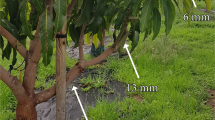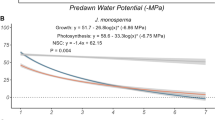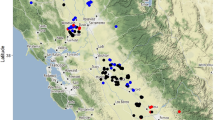Abstract
Trees present a critical challenge to long-distance transport because as a tree grows in height and the transport pathway increases in length, the hydraulic resistance of the vascular tissue should increase. This has led many to question whether trees can rely on a passive transport mechanism to move carbohydrates from their leaves to their roots. Although species that actively load sugars into their phloem, such as vines and herbs, can increase the driving force for transport as they elongate, it is possible that many trees cannot generate high turgor pressures because they do not use transporters to load sugar into the phloem. Here, we examine how trees can maintain efficient carbohydrate transport as they grow taller by analysing sieve tube anatomy, including sieve plate geometry, using recently developed preparation and imaging techniques, and by measuring the turgor pressures in the leaves of a tall tree in situ. Across nine deciduous species, we find that hydraulic resistance in the phloem scales inversely with plant height because of a shift in sieve element structure along the length of individual trees. This scaling relationship seems robust across multiple species despite large differences in plate anatomy. The importance of this scaling becomes clear when phloem transport is modelled using turgor pressures measured in the leaves of a mature red oak tree. These pressures are of sufficient magnitude to drive phloem transport only in concert with structural changes in the phloem that reduce transport resistance. As a result, the key to the long-standing mystery of how trees maintain phloem transport as they increase in size lies in the structure of the phloem and its ability to change hydraulic properties with plant height.
This is a preview of subscription content, access via your institution
Access options
Access Nature and 54 other Nature Portfolio journals
Get Nature+, our best-value online-access subscription
$29.99 / 30 days
cancel any time
Subscribe to this journal
Receive 12 digital issues and online access to articles
$119.00 per year
only $9.92 per issue
Buy this article
- Purchase on Springer Link
- Instant access to full article PDF
Prices may be subject to local taxes which are calculated during checkout






Similar content being viewed by others
References
Knoblauch, M. & Oparka, K. The structure of the phloem—still more questions than answers. Plant J. 70, 147–156 (2012).
De Schepper, V., De Swaef, T., Bauweraerts, I. & Steppe, K. Phloem transport: a review of mechanisms and controls. J. Exp. Bot. 64, 4839–4850 (2013).
Münch, E. Material Flow in Plants (trans. Milburn, J. A. & Kreeb, K. H., Univ. Bremen, 2003) (Gustav Fischer, Jena, 1930).
Thompson, M. V. & Holbrook, N. M. Scaling phloem transport: water potential equilibrium and osmoregulatory flow. Plant Cell Environ. 26, 1561–1577 (2003).
Jensen, K. H., Rio, E., Hansen, R., Clanet, C. & Bohr, T. Osmotically driven pipe flows and their relation to sugar transport in plants. J. Fluid Mech. 636, 371–396 (2009).
LaBarbera, M. Principles of design of fluid transport systems in zoology. Science 249, 992–1000 (1990).
Knoblauch, M. et al. Testing the Münch hypothesis of long distance phloem transport in plants. eLife 5, e15341 (2016).
Lalonde, S., Wipf, D. & Frommer, W. B. Transport mechanisms for organic forms of carbon and nitrogen between source and sink. Annu. Rev. Plant Biol. 55, 341–372 (2004).
Rennie, E. A. & Turgeon, R. A comprehensive picture of phloem loading strategies. Proc. Natl Acad. Sci. USA 106, 14162–14167 (2009).
Turgeon, R. The puzzle of phloem pressure. Plant Physiol. 154, 578–581 (2010).
West, G. B., Brown, J. H. & Enquist, B. J. A general model for the structure and allometry of plant vascular systems. Nature 400, 664–667 (1999).
McCulloh, K. A., Sperry, J. S. & Adler, F. R. Water transport in plants obeys Murray’s law. Nature 421, 939–942 (2003).
Murray, C. D. The physiological principle of minimum work: I. The vascular system and the cost of blood volume. Proc. Natl Acad. Sci. USA 12, 207–214 (1926).
Anfodillo, T., Carraro, V., Carrer, M., Fior, C. & Rossi, S. Convergent tapering of xylem conduits in different woody species. New Phytol. 169, 279–290 (2006).
Mencuccini, M. Hydraulic constraints in the functional scaling of trees. Tree Physiol. 22, 553–565 (2002).
Enquist, B. J. Cope’s rule and the evolution of long-distance transport in vascular plants: allometric scaling, biomass partitioning and optimization. Plant Cell Environ. 26, 151–161 (2003).
Savage, V. M. et al. Hydraulic trade-offs and space filling enable better predictions of vascular structure and function in plants. Proc. Natl Acad. Sci. USA 107, 22722–22727 (2010).
Turgeon, R. & Wolf, S. Phloem transport: cellular pathways and molecular trafficking. Annu. Rev. Plant Biol. 60, 207–221 (2009).
van Bel, A. J. E., Ehlers, K. & Knoblauch, M. Sieve elements caught in the act. Trends Plant Sci. 7, 126–132 (2002).
Eschrich, W. in Transport in Plants I: Phloem Transport (Encyclopedia of Plant Physiology) Vol. 1 (eds Zimmermann, M. H. & Milburn, J. A.) 39–56 (Springer, Berlin, 1975).
Jensen, K. H. et al. Optimality of the Münch mechanism for translocation of sugars in plants. J. R. Soc. Interface 8, 1155–1165 (2011).
Pickard, W. F. Münch without tears: a steady-state Münch-like model of phloem so simplified that it requires only algebra to predict the speed of translocation. Funt. Plant Biol. 39, 531–537 (2012).
Hölttä, T., Mencuccini, M. & Nikinmaa, E. Linking phloem function to structure: analysis with a coupled xylem–phloem transport model. J. Theor. Biol. 259, 325–337 (2009).
Petit, G. & Crivellaro, A. Comparative axial widening of phloem and xylem conduits in small woody plants. Trees 28, 915–921 (2014).
Jyske, T. & Hölttä, T. Comparison of phloem and xylem hydraulic architecture in Picea abies stems. New Phytol. 205, 102–115 (2015).
Rosner, S., Baier, P. & Kikuta, S. B. Osmotic potential of Norway spruce Picea abies (L.) Karst. secondary phloem in relation to anatomy. Trees 15, 472–482 (2001).
Woodruff, D. R. The impacts of water stress on phloem transport in Douglas-fir trees. Tree Physiol. 34, 5–14 (2014).
Jensen, K. H. et al. Modeling the hydrodynamics of phloem sieve plates. Front. Plant Sci. 3, 151 (2012).
Liesche, J., Pace, M. R., Xu, Q., Li, Y. & Chen, S. Height‐related scaling of phloem anatomy and the evolution of sieve element end wall types in woody plants. New Phytol. 214, 245–256 (2017).
Knoblauch, M. & Peters, W. S. What actually is the Münch hypothesis? A short history of assimilate transport by mass flow. J. Integr. Plant Biol. 59, 292–310 (2017).
Ryan, M. G. & Asao, S. Phloem transport in trees. Tree Physiol. 34, 1–4 (2014).
Mullendore, D. L., Windt, C. W., Van As, H. & Knoblauch, M. Sieve tube geometry in relation to phloem flow. Plant Cell 22, 579–593 (2010).
Knoblauch, J., Mullendore, D. L., Jensen, K. H. & Knoblauch, M. Pico gauges for minimally invasive intracellular hydrostatic pressure measurements. Plant Physiol. 166, 1271–1279 (2014).
Jensen, K. H., Savage, J. A. & Holbrook, N. M. Optimal concentration for sugar transport in plants. J. R. Soc. Interface 10, 20130055 (2013).
Liesche, J., Windt, C., Bohr, T., Schulz, A. & Jensen, K. H. Slower phloem transport in gymnosperm trees can be attributed to higher sieve element resistance. Tree Physiol. 35, 376–386 (2015).
De Schepper, V. et al. 11C-PET imaging reveals transport dynamics and sectorial plasticity of oak phloem after girdling. Front. Plant Sci. 4, 200 (2013).
Canny, M. J. Phloem Translocation 205–207 (Cambridge Univ. Press, Cambridge, 1973).
Windt, C. W., Vergeldt, F. J., De Jager, P. A. & Van As, H. MRI of long-distance water transport: a comparison of the phloem and xylem flow characteristics and dynamics in poplar, castor bean, tomato and tobacco. Plant Cell Environ. 29, 1715–1729 (2006).
Gould, N., Thorpe, M. R., Koroleva, O. & Minchin, P. E. H. Phloem hydrostatic pressure relates to solute loading rate: a direct test of the Münch hypothesis. Funt. Plant Biol. 32, 1019–1026 (2005).
Oner-Sieben, S. & Lohaus, G. Apoplastic and symplastic phloem loading in Quercus robur and Fraxinus excelsior. J. Exp. Bot. 65, 1905–1916 (2014).
Liesche, J., Martens, H. J. & Schulz, A. Symplasmic transport and phloem loading in gymnosperm leaves. Protoplasma 248, 181–190 (2011).
Croser, C., Bengough, A. G. & Pritchard, J. The effect of mechanical impedance on root growth in pea (Pisum sativum). II. Cell expansion and wall rheology during recovery. Physiol. Plant. 109, 150–159 (2000).
Pritchard, J. Aphid stylectomy reveals an osmotic step between sieve tube and cortical cells in barley roots. J. Exp. Bot. 47, 1519–1524 (1996).
Rygol, J., Pritchard, J., Zhu, J. J., Tomos, A. D. & Zimmermann, U. Transpiration induces radial turgor pressure gradients in wheat and maize roots. Plant Physiol. 103, 493–500 (1993).
Sperry, J. S., Hacke, U. G. & Wheeler, J. K. Comparative analysis of end wall resistivity in xylem conduits. Plant Cell Environ. 28, 456–465 (2005).
van Bel, A. J. E. The phloem, a miracle of ingenuity. Plant Cell Environ. 26, 125–149 (2003).
Fensom, D. S. The bio-electric potentials of plants and their functional signficance: I. An electrokinetic theory of transport. Can. J. Bot. 35, 573–582 (1957).
Spanner, D. C. The translocation of sugar in sieve tubes. J. Exp. Bot. 9, 332–342 (1958).
Lang, A. Relay mechanism for phloem translocation. Ann. Bot. 44, 141–145 (1979).
Aikman, D. P. Contractile proteins and hypotheses concerning their role in phloem transport. Can. J. Bot. 58, 826–832 (1980).
Comtet, J., Jensen, K. H., Turgeon, R., Stroock, A. D. & Hosoi, A. E. Passive phloem loading and long-distance transport in a synthetic tree-on-a-chip. Nat. Plants 3, 17032 (2017).
Turgeon, R., Medville, R. & Nixon, K. C. The evolution of minor vein phloem and phloem loading. Am. J. Bot. 88, 1331–1339 (2001).
Gamalei, Y. Phloem loading and its development related to plant evolution from trees to herbs. Trees 5, 50–64 (1991).
Carvalho, M. R., Turgeon, R., Owens, T. & Niklas, K. J. The scaling of the hydraulic architecture in poplar leaves. New Phytol. 214, 145–157 (2017).
Woodruff, D. R., Bond, B. J. & Meinzer, F. C. Does turgor limit growth in tall trees? Plant Cell Environ. 27, 229–236 (2004).
Ryan, M. G. & Yoder, B. J. Hydraulic limits to tree height and tree growth. Bioscience 47, 235–242 (1997).
Koch, G. W., Sillett, S. C., Jennings, G. M. & Davis, S. D. The limits to tree height. Nature 428, 851–854 (2004).
Mencuccini, M., Hölttä, T. & Martínez-Vilalta, J. in Size- and Age-Related Changes in Tree Structure and Function (eds Meinzer, F. C. et al.) 309–339 (Springer, New York, NY, 2011).
Aloni, R. Control of xylogenesis within the whole tree. Ann. For. Sci. 46, 267s–272s (1989).
Anfodillo, T. et al. Widening of xylem conduits in a conifer tree depends on the longer time of cell expansion downwards along the stem. J. Exp. Bot. 63, 837–845 (2012).
Savage, J. A., Haines, D. F. & Holbrook, N. M. The making of giant pumpkins: how selective breeding changed the phloem of Cucurbita maxima from source to sink. Plant Cell Environ. 38, 1543–1554 (2015).
Savage, J. A. et al. Allocation, stress tolerance and carbon transport in plants: how does phloem physiology affect plant ecology? Plant Cell Environ. 39, 709–725 (2016).
Scholz, A., Klepsch, M., Karimi, Z. & Jansen, S. How to quantify conduits in wood? Front. Plant Sci. 4, 56 (2013).
Ruzin, S. E. Plant Microtechnique and Microscopy 132 (Oxford Univ. Press, Oxford, 1999).
Phillips, R. J. & Dungan, S. R. Asymptotic analysis of flow in sieve tubes with semi-permeable walls. J. Theor. Biol. 162, 465–485 (1993).
Thompson, M. V. & Holbrook, N. M. Application of a single-solute non-steady-state phloem model to the study of long-distance assimilate transport. J. Theor. Biol. 220, 419–455 (2003).
Jensen, K. H. et al. Sap flow and sugar transport in plants. Rev. Mod. Phys. 88, 035007 (2016).
Acknowledgements
Funding was provided by the National Science Foundation (IOS 1021779 and 1456682 to N.M.H. and M.K.), a Katharine H. Putnam Fellowship in Plant Science (J.A.S.), a Harvard Bullard Fellowship (M.K.), and the University of Minnesota Duluth (J.A.S.). Samples were collected at the Arnold Arboretum of Harvard University (permit no. 22-2013), the Harvard Forest and the main campus of Harvard University. Imaging was completed at the Harvard Center for Biological Imaging, Franceschi Microscopy and Imaging Center at WSU, the Center for Nanoscale Systems (Harvard University) and the Weld Hill Microscopy Lab at the Arnold Arboretum.
Author information
Authors and Affiliations
Contributions
J.A.S., K.H.J., M.K. and N.M.H. designed the research. J.A.S., S.D.B., L.C., J.T.G., J.K., M.K. and J.M.L. collected the data and standardized protocols. J.A.S. and K.H.J. analysed the data. J.A.S., N.M.H., K.H.J. and M.K. wrote the paper.
Corresponding author
Ethics declarations
Competing interests
The authors declare no competing financial interests.
Additional information
Publisher’s note: Springer Nature remains neutral with regard to jurisdictional claims in published maps and institutional affiliations.
Electronic supplementary material
Supplementary Information
Supplementary Tables 1–6, Supplementary Figures 1–3, Supplementary Information 2.
Rights and permissions
About this article
Cite this article
Savage, J.A., Beecher, S.D., Clerx, L. et al. Maintenance of carbohydrate transport in tall trees. Nature Plants 3, 965–972 (2017). https://doi.org/10.1038/s41477-017-0064-y
Received:
Accepted:
Published:
Issue Date:
DOI: https://doi.org/10.1038/s41477-017-0064-y
This article is cited by
-
Dual-Ion Co-Regulation System Enabling High-Performance Electrochemical Artificial Yarn Muscles with Energy-Free Catch States
Nano-Micro Letters (2023)
-
Age-related pattern in bark formation of Betula ermanii growing in volcanic environments from southern Sakhalin and Kuril Islands (Northeast Asia)
Trees (2022)
-
Conductivity of the phloem in mango (Mangifera indica L.)
Horticulture Research (2021)
-
Zero-calorie sugar delivery to roots
Nature Plants (2017)



